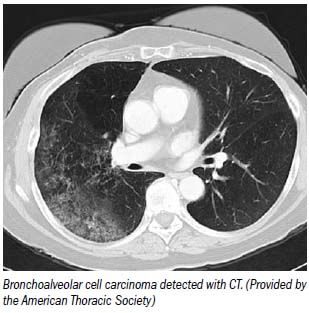CT not yet winning support for lung cancer screening
A study finding relatively high false-positive rates for CT screening of lung cancer will probably not be the definitive word on the subject.
A study finding relatively high false-positive rates for CT screening of lung cancer will probably not be the definitive word on the subject. At least one key player, the American Lung Association, said it would withhold judgment about whether using CT to screen for lung cancer is beneficial for smokers.
Until data from a National Cancer Institute study comes out, the ALA remains undecided about whether CT is an effective lung cancer screening tool, according to Dr. Normal Edelman, the organization's chief medical officer. The National Cancer Institute study, the ongoing National Lung Screening Trial, examines how well both x-ray and CT perform to determine which can detect lung cancer better. Results from the study are expected by next year.

The latest findings on the use of CT for lung cancer screening, published in the April Annals of Internal Medicine, show a high number of false positives. Out of 3190 patients, the risk for false positives was 21%. After two CT scans, the risk increased to 33% (Ann Intern Med 2010;152[7]:505-512).
The National Lung Screening Trial could also put to rest some of the controversy that has dogged the debate over the past few years.
In 2007, lead investigator Dr. Claudia Henschke, chief of the divisions of chest imaging and healthcare policy and technology assessment at Weill Medical College of Cornell University in New York City, published a computer modeling study predicting that 80% of people whose lung cancer was caught early with CT screening could expect to live at least another decade (Radiology 2007;243[1]:239- 249; NEJM 2006;355[17]:1763-1771).
Critics and proponents debated issues such as lead time bias, the risks of false-positive results, and the lack of data on overall mortality. And in 2008 it was reported that tobacco money helped finance the I-ELCAP program.
Weill Medical College stood behind its work, saying the tobacco money for I-ELCAP had been publicly disclosed. In addition, the university maintained the company's gift was unrestricted, which allowed for completely independent research.
The National Lung Screening Trial should provide more definitive answers. Thus far though, the outlook for CT does not look good.
In the Annals of Internal Medicine study the researchers analyzed data from a feasibility pilot study performed Bronchoalveolar cell carcinoma detected with CT. (Provided by the American Thoracic Society) before the National Lung Screening Trial was launched. Portions of the study were presented at the American Society of Clinical Oncology meeting last year by Dr. Jennifer Croswell, acting director of the National Institute of Health's Office of Medical Applications of Research.
The researchers randomly assigned 3190 current or former smokers to receive either a chest x-ray or a CT scan with repeated testing after one year if the first test result was normal. They followed patients with abnormal test results to see whether they were true-positive or false-positive results. The researchers then followed the patients for 12 months after the final screening test to see who developed cancer.
“Right now we don't support the idea of routinely using this method for screening,” said Dr. Norman Edelman, chief medical officer of the ALA. “I'm not talking about diagnosis or other things, just screening.”
One of concerns about the false positive rate for CT lung cancer screening is the relative invasiveness of lung nodule biopsies. A false positive on a mammogram is ruled out by a needle biopsy. A false positive on a CT scan of the lung is ruled out by opening up the chest.
When considering whether to make CT lung cancer screening public policy, both the risks and the costs of having to perform surgical biopsy on many patients with possibly false positive test results must be taken into account.
“At a public health level, we have to consider benefits against cost in large numbers of people,” Edelman said. “The American Lung Association doesn't think at this point there's enough evidence for that to be good policy.”
Whether Medicare should pay for screening is another point that would have to be decided.
“We're not dissing the method, we haven't decided it's not effective,” he said. “We're waiting for the evidence.”
Could Lymph Node Distribution Patterns on CT Improve Staging for Colon Cancer?
April 11th 2025For patients with microsatellite instability-high colon cancer, distribution-based clinical lymph node staging (dCN) with computed tomography (CT) offered nearly double the accuracy rate of clinical lymph node staging in a recent study.
AMA Approves Category III CPT Codes for AI-Enabled Perivascular Fat Analysis from CT Scans
April 9th 2025Going into effect in 2026, the new CPT codes may facilitate increased adoption of the CaRi-Heart software for detecting coronary inflammation from computed tomography scans pending FDA clearance of the technology.
The Reading Room: Racial and Ethnic Minorities, Cancer Screenings, and COVID-19
November 3rd 2020In this podcast episode, Dr. Shalom Kalnicki, from Montefiore and Albert Einstein College of Medicine, discusses the disparities minority patients face with cancer screenings and what can be done to increase access during the pandemic.
Study with CT Data Suggests Women with PE Have More Than Triple the One-Year Mortality Rate than Men
April 3rd 2025After a multivariable assessment including age and comorbidities, women with pulmonary embolism (PE) had a 48 percent higher risk of one-year mortality than men with PE, according to a new study involving over 33,000 patients.
GE HealthCare Debuts AI-Powered Cardiac CT Device at ACC Conference
April 1st 2025Featuring enhanced low-dose image quality with motion-free images, the Revolution Vibe CT system reportedly facilitates improved diagnostic clarity for patients with conditions ranging from in-stent restenosis to atrial fibrillation.